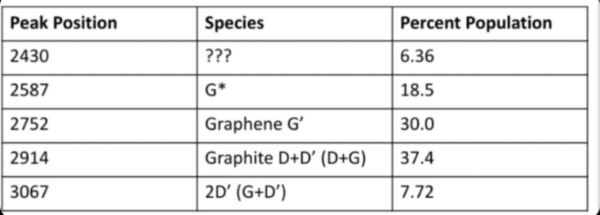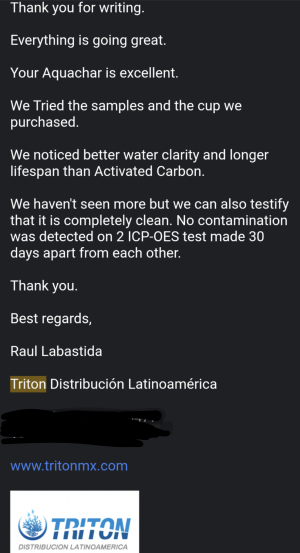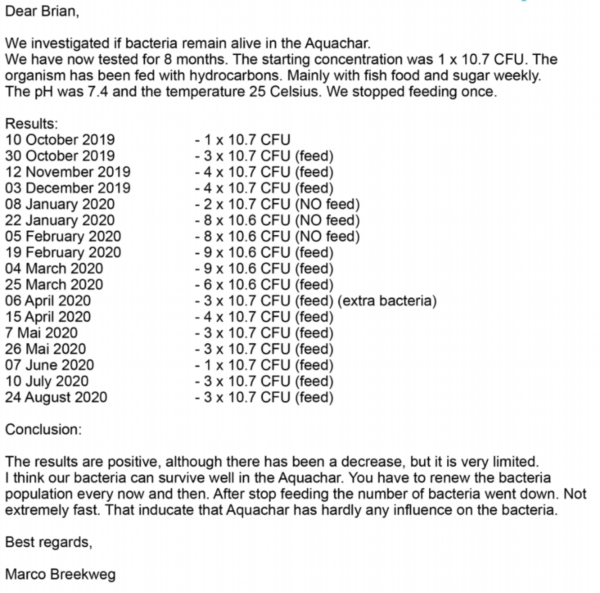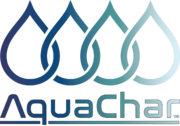![]()
DETERIMINING THE STRUCTURE
![]()
When AquaChar was introduced, hobbyist found the idea of carbon as a biological media intriguing.
Not all carbon is the same. With temperature you get structuring. Pencil lead and diamonds are both forms of structured carbon with vastly different characteristic.
We worked with Iowa State University to perform RAMAN Spectrograph tests to determine the structure of AquaChar carbon.
When we got the results it showed 30% graphene on the surface of AquaChar.
We worked with Iowa State University to perform RAMAN Spectrograph tests to determine the structure of AquaChar carbon.
![]()
When we got the results it showed 30% graphene on the surface of AquaChar.

![]()
The following case studies by well-respected companies were done with random samples of AquaChar to out of curiosity of our claims of long-term biological use without leaching.
![]()
DETERMINING THE CLEANLINESS
Building off early momentum, we provided 3,200 samples to vendors and attendees at Marine Aquarium Conference of North America (MANCA) 2019. Among the interesting people we met at the show was Raul from Triton Latin America. He purchased AquaChar to run a random sampling on his personal aquarium and promised to let us know any positive or negative results.
ICP-OED Analysis determines any elements that can leach into water.
![]()
ICP-OED Analysis determines any elements that can leach into water.
![]()
At MACNA 2019 Raul with Triton Latin America purchased AquaChar to test on his personal tank with these results:
![]()
“Your Aquachar is excellent. We Tried the samples and the cup we purchased. We noticed better water clarity and longer lifespan than Activated Carbon. We haven’t seen more but we can also testify that it is completely clean. No contamination was detected on 2 ICP-OES test made 30 days apart from each other.”
![]()
On October 8th of 2019 we received an email from Raul. “Your Aquachar is excellent. We Tried the samples and the cup we purchased. We noticed better water clarity and longer lifespan than Activated Carbon. We haven’t seen more but we can also testify that it is completely clean. No contamination was detected on 2 ICP-OES test made 30 days apart from each other.”

![]()
FOOD OR FOOD DELIVERY
![]()
After learning about AquaChar through our shared distributor in Holland, Marco Breekweg – a successful bacteriologist and owner of MicroBac – joined us at Reefapalooza New York because he was intrigued by a carbon with enough porosity to become a microsite while pulling impurities from the water and maintaining a desired pH range.
After learning about AquaChar through our shared distributor in Holland, Marco Breekweg – a successful bacteriologist and owner of MicroBac – joined us at Reefapalooza New York because he was intrigued by a carbon with enough porosity to become a microsite while pulling impurities from the water and maintaining a desired pH range.
He had been testing biochar as a biological medium but found when used in hydroponics harmful impurities would leach over time impacting the ability for microorganisms to function.
Two days after we sent him our ICP-OES results he began an eight-month long laboratory case study at his research University to test if how his strains bacteria reacted to AquaChar as a biological substrate.
![]()
![]()
LABORITORY CASE STUDY
The results presented to us was an eight-month study from October 10th, 2019 through August 24th, 2020.
The results presented to us was an eight-month study from October 10th, 2019 through August 24th, 2020.
![]()
This case study was designed to test the general interaction with AquaChar and bacillus and Nitrobacter strains of bacteria.
This case study was designed to test the general interaction with AquaChar and bacillus and Nitrobacter strains of bacteria.
The pH was stable at 7.4 and temperature was maintained consistent at 25 degrees Celsius.
For the first three months there was a weekly diet of hydrocarbons consisting of fish food and sugar.
Then for the next month no food was added to see if AquaChar was a food source for bacteria and to see how well the colony recovers.
Six months in it was needed to re-dose bacteria to see if AquaChar is an environment where new bacteria will live and maintain a population.
![]()
![]()
MICROBAC SUMMARY OF RESULTS

![]()
WHAT THIS MEANS
![]()
AquaChar is the first aquarium filtration product to get temperature high enough to tests for graphene structuring.
AquaChar is the first aquarium filtration product to get temperature high enough to tests for graphene structuring.
![]()
AquaChar does not leach or contain anything harmful to microorganisms.
AquaChar does not leach or contain anything harmful to microorganisms.
![]()
Bacteria quadrupled in the first few months of the experiment.
Bacteria quadrupled in the first few months of the experiment.
![]()
The system’s biological consumption is tied to inputs.
AquaChar is not a food source for bacteria but the ability of carbon to pull organics allows for the colonization.
AquaChar is not a food source for bacteria but the ability of carbon to pull organics allows for the colonization.
Adjustments to the feeding and adding new livestock can greatly impact biological stability.
Dosing of microorganisms is needed to maintain stability in long-term husbandry.
Each weak there is a myriad of problems microorganisms solve that we don’t know about. Eventually dominant species emerge which creates breaks in the chain of decomposition.
It is good practice to remember biological diversity.
When a system is stable and inputs are consistent, balance can be easily achieved with consistency and routine.
![]()
CONCLUSION
![]()
While testing on these projects are ongoing these results show that AquaChar not only does chemical filtration longer but also becomes a long-term biological microsite.
Bacteria have adapted over hundreds of millions of years to colonize wood-based carbon to regenerate after forest fires.
Bacteria have adapted over hundreds of millions of years to colonize wood-based carbon to regenerate after forest fires.
![]()
The leaching and short-term use of other carbons has made ceramic media a more popular media in the hobby today.
The leaching and short-term use of other carbons has made ceramic media a more popular media in the hobby today.
![]()
AquaChar was designed to replace ceramic bio-media.
AquaChar was designed to replace ceramic bio-media.
![]()
Ceramic media tends to be broken down by CO2 and other acids created in the system over time and can leach metals and other elements into the water column.
The carbon bonds of AquaChar does not break down.
AquaChar actively pulls fine consumable organic from the water and has the size and internal porosity needed to allow nitrifying and decomposing bacteria to more efficiently clarify and break down organics.
AquaChar actively pulls fine consumable organic from the water and has the size and internal porosity needed to allow nitrifying and decomposing bacteria to more efficiently clarify and break down organics.
![]()
![]()
